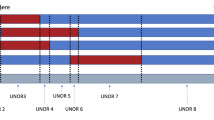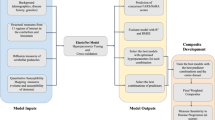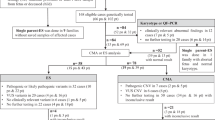Abstract
The Friedreich’s ataxia locus (FRDA) maps on chromosome 9q13. Genetic data, obtained from a small number of recombination events, indicated that the FRDA locus might be located centromeric to the D9S15/D9S5 linkage group, the most probable order being cen-FRDA-D9S5-D9S111-D9S15-D9S110-qter. Recently, new centromeric markers have been reported. Analysis of these markers allowed us to localize the recombination breakpoint in some of the recombinant families. However, only one proximal recombination has been found with these markers. To increase the genetic information from FRDA families, we have analyzed the centromeric markers FR1, FR2, FR7, FR8, and FR5 in patients homozygous by descent. These were ascertained because parents were consanguineous or because they were homozygous for the entire haplotype D9S15 or D9S111-D9S5-D9S411E-D9S202. Haplotype divergence for, at least, two contiguous markers was observed in two patients homozygous for the core D9S111-FR2 haplotype and in one third-degree consanguineous family homozygous for haplotype D9S411E-FR5. Interpretation of divergence as the result of ancient meiotic crossovers allowed the definition of three new recombination events which place the FRDA locus within the interval defined by markers D9S411E and FR8. A consanguineous family with first-cousin parents showed homozygosity only at D9S202 and FR2. Further investigations are needed to discern whether two different mutations are segregating in the family or whether two recombinations, one distal and one proximal, have taken place.
Similar content being viewed by others
Log in or create a free account to read this content
Gain free access to this article, as well as selected content from this journal and more on nature.com
or
References
Harding AE: Friedreich’s ataxia: A clinical and genetic study of 90 families with analysis of early diagnostic criteria and intrafamilial clustering of clinical features. Brain 1981;104:589–662
Winter RM, Harding AE, Baraitser M, Bravery MB: Intrafamilial correlation in Friedreich’s ataxia. Clin Genet 1981;20:419–427
Romeo G, Menozzi P, Ferlini A, Fadda S, DiDonato S, Uziel G, Lucci B, et al: Incidence of Friedreich ataxia in Italy estimated from consanguineous marriages. Am J Hum Genet 1983;35:523–529
Chamberlain S, Shaw J, Rowland S, Wallis J, South S, Nakamura Y, von Gabain A, et al: Mapping of the mutation causing Friedreich’s ataxia to chromosome 9. Nature 1988;334:248–250
Fujita R, Agid Y, Trouillas P, Seck A, Tommasi-Davenas C, Driesel AJ, Olek K, et al: Confirmation of linkage of Friedreich’s ataxia to chromosome 9 and identification of a new closely linked marker. Genomics 1989;4:110–111
Chamberlain S, Shaw J, Wallis J, Rowland A, Chow L, Farrall M, Keats B, et al: Genetic homogeneity at the Friedreich ataxia locus on chromosome 9. Am J Hum Genet 1989;44:518–521
Fujita R, Hanauer A, Sirugo G, Heiling R, Mandel JL: Additional polymorphisms at marker loci D9S5 and D9S15 generate extended haplotypes in linkage disequilibrium with Friedreich ataxia. Proc Natl Acad Sci USA 1990;87:1776–1800
Pandolfo M, Sirugo G, Antonelli A, Weitnauer L, Ferretti L, Leone M, Dones I, et al: Friedreich ataxia in Italian families: Genetic homogeneity and linkage disequilibrium with the marker loci D9S5 and D9S15. Am J Hum Genet 1990;47:228–235
Fujita R, Hanauer A, Vincent A, Mandel JL, Koenig M: Physical mapping of two loci (D9S5 and D9S15) thightly linked to the Friedreich’s ataxia locus (FRDA) and identification of nearby CpG islands by pulse-field gel electrophoresis. Genomics 1991;10:915–920
Fujita R, Sirugo G, Duclos F, Abderrahim H, Le Pasleir D, Cohen D, Brownstein BH, et al: A 530 kb YAC contig tightly linked to Friedreich ataxia locus contains 5 CpG clusters and a new highly polymorphic microsatellite. Hum Genet 1992;89:531–538
Chamberlain S, Farrall M, Shaw J, Wilkes D, Carvajal J, Hillerman R, Doudney K, et al: Genetic recombination events which position the Friedreich ataxia locus proximal to the D9S15/D9S5 linkage group on chromosome 9q. Am J Hum Genet 1993;52:99–109
Belal S, Kyproula P, Sirugo G, Ben Hamida C, Panos I, Hentati F, Beckman J, et al: Study of large inbred Friedreich ataxia families reveals a recombination between D9S15 and the disease locus. Am J Hum Genet 1992;51:1372–1376
Rodius F, Duclos F, Wrogemann K, Le Paslier D, Ougen P, Billault A, Belal S, et al: Recombinations in individuals homozygous by descent localize the Friedreich ataxia locus in a cloned 450-kb interval. Am J Hum Genet 1994;54:1050–1059
Palau F, Monrós E, Prieto F, Vilchez JJ, Lopez-Arlandis JM: Genetic diagnosis of Friedreich ataxia. Lancet 1991;338:1087.
Palau F, Löfgren A, De Jonghe P, Bort S, Nelis E, Sevilla T, Martin JJ, Vilchez J, Prieto F, Van Broeckhoven C: Origin of the de novo cuplication in Charcot-Marie-Tooth disease type 1A: Unequal nonsister chromatid exchange during spermatogenesis. Hum Mol Genet 1993;2:2031–2035
Beidler JL, Hilliard PR, Rill RL: Ultrasensitive staining for nucleic acids with silver. Anal Biochem 1982;126:374–380
Carlsson M, Nakamura Y, Krapcho K, Fujimoto E, O’Connell P, Leppert M, Lathrop GM, et al: Isolation and mapping of a polymorphic DNA sequence pMCT112 on chromosome 9q (D9S15). Nucleic Acids Res 1987;15:10614.
Orzechowski HDD, Henning J, Winter P, Grzeschik KH, Olek K, Driesel AJ: A human single-copy DNA probe (DR47) detects a TaqI RFLP on chromosome 9 (D9S5). Nucleic Acids Res 1987;15:6310.
Wallis J, Williamson R, Chamberlain S: Identification of a hypervariable microsatellite polymorphism within D9S15 tightly linked to Friedreich’s ataxia. Hum Genet 1990;85:98–100
Sirugo G, Keats B, Fujita R, Duclos F, Purohit K, Koenig M, Mandel JL: Friedreich ataxia in Lousiana-Acadians: Demonstration of a founder effect by analysis of microsatellite generated extended haplotypes. Am J Hum Genet 1992;50:559–566
Pugachev VV, Polyahov L, Prokunina L, Evgrafov OV: Molecular and genetic study of FRDA locus in Russia. Int Workshop on the Molecular Genetics of Friedreich’s and Dominant Ataxias, Capri 1993, pp 18–19.
Duclos F, Boschert U, Sirugo G, Mandel JL, Koenig M: New gene in the region of the Friedreich ataxia locus encodes a putative transmembrane protein expressed in the nervous system. Proc Natl Acad Sci USA 1993;90:109–113
Pandolfo M, Murano M, Cocozza S, Redolfi EM, Pianese L, Cavalcanti F, Monticelli A, et al: A dinucleotide repeat polymorphism (D9S202) in the Friedreich’s ataxia region on chromosome 9q13-q21.1. Hum Mol Genet 1993;2:822.
Sirugo G, Cocozza S, Brice A, Cavalcanti F, De Michele G, Dones I, Filla A, et al: Linkage disequilibrium analysis of Friedreich’s ataxia in 140 Caucasian families: Positioning of the disease locus and evaluation of allelic heterogeneity. Eur J Hum Genet 1993;1:133–143
Hanauer A, Chery M, Fujita R, Driesel AJ, Gilgenkranz S, Mandel JL: The Friedreich ataxia gene is assigned to chromosome 9q13-q21 by mapping tightly linked markers and shows linkage disequilibrium with D9S15. Am J Hum Genet 1990;46:133–137
Lander ES, Botstein D: Homozygosity mapping: A way to map human recessive traits with the DNA of inbred children. Science 1987,236:1567–1570.
Ben Hamida M, Belal S, Sirugo G, Ben Hamida C, Panayides K, Ioannou P, Beckmann J, et al: Friedreich’s ataxia phenotype not linked to chromosome 9 and associated to selective autosomal recessive vitamin E deficiency in two inbred Tunisian families. Neurology 1993;43:2179–2183
Ben Hamida C, Doerflinger N, Belal S, Linder C, Retenauer L, Dib C, Gyapay G, et al: Localization of Friedreich ataxia phenotype associated with selective vitamin E deficiency to proximal 8q by homozygosity mapping. Nat Genet 1993;5:195–200
Acknowledgements
We thank Dr. Y. Nakamura and Dr. J.L. Mandel for probes MCT112 and 26P, respectively, and the Friedreich’s ataxia families and the Asociación Española de Ataxias Hereditarias for their enthusiastic cooperation. This study was supported by grants from the Comisión Interministerial de Ciencia y Tecnología, CICYT and from the Generalitat Valenciana (FP), from the Association Française contre les Myopathies and the Groupement de Recherche et d’Etudes sur les Génomes (MK) and from Italian Telethon (MP). EM and JC are recipients of a Generalitat Valenciana Fellowship.
Author information
Authors and Affiliations
Rights and permissions
About this article
Cite this article
Monrós, E., Smeyers, P., Rodius, F. et al. Mapping of Friedreich’s Ataxia Locus by Identification of Recombination Events in Patients Homozygous by Descent. Eur J Hum Genet 2, 291–299 (1994). https://doi.org/10.1159/000472373
Received:
Revised:
Accepted:
Issue date:
DOI: https://doi.org/10.1159/000472373
Key Words
This article is cited by
-
A family segregating a Friedreich ataxia phenotype that is not linked to the FRDA locus
Human Genetics (1996)



